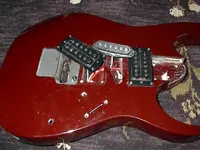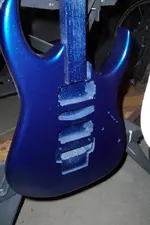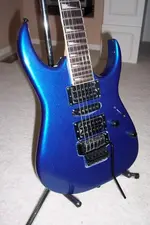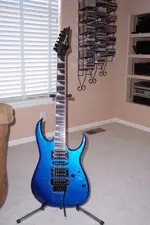guitarded2
New member
Ok here is the scoop. I have been procrastinating painting/fixing up my guitar for a while. It is an Ibanez DTX120 (yeah yeah ugly destroyer/iceman wanna be) Finally the guitar broke down to a point where the only way to fix it was to replace the volume 500k pot. I decided to put a 250k pot in it to make it less bright I switched the pickups from the stock humbucking pickups to a seymour duncan (bridge) and duncan design (neck) The pickups worked for a while but then the wires in the guitar were put in too sloppy and shorted out because of my sloppy soldering. I just ripped out the electronics and went to a music store and bought a new 3 way switcher thingy and two 250k pots. I had another input jack laying around the house so I had everything I needed. I tried to drill a hole into the guitar because the pickup wires were not fitting through the hole. After getting it stuck into the body I brutally beat the drill bit out  . I got a bigger hole from it but the paint on the body was pretty much gone thanks to my bipolar episode
. I got a bigger hole from it but the paint on the body was pretty much gone thanks to my bipolar episode . I decided to paint it I used a hand sander got all the layers of paint and clear coat off, sprayed the primer over the guitar (ten layers), waited 15 minutes between each, let it dry over night, sprayed the metallic spray paint over it about 8 times using the same formula as the primer, and I waited over night, I looked at it today and it was a little wet it eventually dried but the problem is that it seems almost grainy Dad recommends that I simply use a rugged cloth to gently sort of sand the linty type pieces off. I am afraid that this might mess it up I sprayed three clear coats on and it just appears that the clear coat is not even doing anything it smells like spray paint but it just doesnt seem to do anything please help me. I love this guitar its technically my first electric guitar and I dont want to lose her. I used the search function and could not find anything useful after reading a ton of websites nothing seemed to help me with my problem.
. I decided to paint it I used a hand sander got all the layers of paint and clear coat off, sprayed the primer over the guitar (ten layers), waited 15 minutes between each, let it dry over night, sprayed the metallic spray paint over it about 8 times using the same formula as the primer, and I waited over night, I looked at it today and it was a little wet it eventually dried but the problem is that it seems almost grainy Dad recommends that I simply use a rugged cloth to gently sort of sand the linty type pieces off. I am afraid that this might mess it up I sprayed three clear coats on and it just appears that the clear coat is not even doing anything it smells like spray paint but it just doesnt seem to do anything please help me. I love this guitar its technically my first electric guitar and I dont want to lose her. I used the search function and could not find anything useful after reading a ton of websites nothing seemed to help me with my problem.
thanks in advance
PS guitar modding is a migrane I think I would rather pay that 2k for a dream guitar rather than lose all of my hair trying to mod one.
 . I got a bigger hole from it but the paint on the body was pretty much gone thanks to my bipolar episode
. I got a bigger hole from it but the paint on the body was pretty much gone thanks to my bipolar episode . I decided to paint it I used a hand sander got all the layers of paint and clear coat off, sprayed the primer over the guitar (ten layers), waited 15 minutes between each, let it dry over night, sprayed the metallic spray paint over it about 8 times using the same formula as the primer, and I waited over night, I looked at it today and it was a little wet it eventually dried but the problem is that it seems almost grainy Dad recommends that I simply use a rugged cloth to gently sort of sand the linty type pieces off. I am afraid that this might mess it up I sprayed three clear coats on and it just appears that the clear coat is not even doing anything it smells like spray paint but it just doesnt seem to do anything please help me. I love this guitar its technically my first electric guitar and I dont want to lose her. I used the search function and could not find anything useful after reading a ton of websites nothing seemed to help me with my problem.
. I decided to paint it I used a hand sander got all the layers of paint and clear coat off, sprayed the primer over the guitar (ten layers), waited 15 minutes between each, let it dry over night, sprayed the metallic spray paint over it about 8 times using the same formula as the primer, and I waited over night, I looked at it today and it was a little wet it eventually dried but the problem is that it seems almost grainy Dad recommends that I simply use a rugged cloth to gently sort of sand the linty type pieces off. I am afraid that this might mess it up I sprayed three clear coats on and it just appears that the clear coat is not even doing anything it smells like spray paint but it just doesnt seem to do anything please help me. I love this guitar its technically my first electric guitar and I dont want to lose her. I used the search function and could not find anything useful after reading a ton of websites nothing seemed to help me with my problem. thanks in advance
PS guitar modding is a migrane I think I would rather pay that 2k for a dream guitar rather than lose all of my hair trying to mod one.


 . I'm braced for a flaming from the pro's but this is a DIY/Homegrown forum so I'm for keeping it real.
. I'm braced for a flaming from the pro's but this is a DIY/Homegrown forum so I'm for keeping it real. ) then smooth it again with 300-400 grit paper.
) then smooth it again with 300-400 grit paper.



